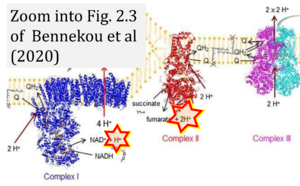Bennekou 2020 OECD
From Bioblast
| Bennekou SH, van der Stel W, Carta G, Eakins J, Delp J, Forsby A, Kamp H, Gardner I, Zdradil B, Pastor M, Gomes JC, White A, Steger-Hartman T, Danen EHJ, Leist M, Walker P, Jennings P, van de Water B (2020) Case stuy on the use of integrated approaches to testing and assessment for mitochondrial Complex-III-mediated neurotoxicity of azoxystrobin - read-across to other strobilurins. OECD Environment, Health and Safety Publications Series on Testing and Assessment No. 327. ENV/JM/MONO(2020)23. https://one.oecd.org/document/ENV/JM/MONO%282020%2923/en/pdf. |
Bennekou SH, van der Stel W, Carta G, Eakins J, Delp J, Forsby A, Kamp H, Gardner I, Zdradil B, Pastor M, Gomes JC, White A, Steger-Hartman T, Danen EHJ, Leist M, Walker P, Jennings P, van de Water B (2020) OECD Environment, Health and Safety Publications
Abstract: The synthetic strobilurin fungicides are derived from the naturally occurring strobilurin A and B. The strobilurins bind to the quinol oxidation site of cytochrome b of complex III (CIII) of the mitochondria which is also their fungicidal mode of action. There are some signals of potential neurotoxicity from in vitro studies by a CIII-mediated mechanism.
• Bioblast editor: Gnaiger E
Hydrogen ion ambiguities in the electron transfer system
Communicated by Gnaiger E (2023-10-08) last update 2023-11-10
- Electron (e-) transfer linked to hydrogen ion (hydron; H+) transfer is a fundamental concept in the field of bioenergetics, critical for understanding redox-coupled energy transformations.
- However, the current literature contains inconsistencies regarding H+ formation on the negative side of bioenergetic membranes, such as the matrix side of the mitochondrial inner membrane, when NADH is oxidized during oxidative phosphorylation (OXPHOS). Ambiguities arise when examining the oxidation of NADH by respiratory Complex I or succinate by Complex II.
- Oxidation of NADH or succinate involves a two-electron transfer of 2{H++e-} to FMN or FAD, respectively. Figures indicating a single electron e- transferred from NADH or succinate lack accuracy.
- The oxidized NAD+ is distinguished from NAD indicating nicotinamide adenine dinucleotide independent of oxidation state.
- NADH + H+ → NAD+ +2{H++e-} is the oxidation half-reaction in this H+-linked electron transfer represented as 2{H++e-} (Gnaiger 2023). Putative H+ formation shown as NADH → NAD+ + H+ conflicts with chemiosmotic coupling stoichiometries between H+ translocation across the coupling membrane and electron transfer to oxygen. Ensuring clarity in this complex field is imperative to tackle the apparent ambiguity crisis and prevent confusion, particularly in light of the increasing number of interdisciplinary publications on bioenergetics concerning diagnostic and clinical applications of OXPHOS analysis.



